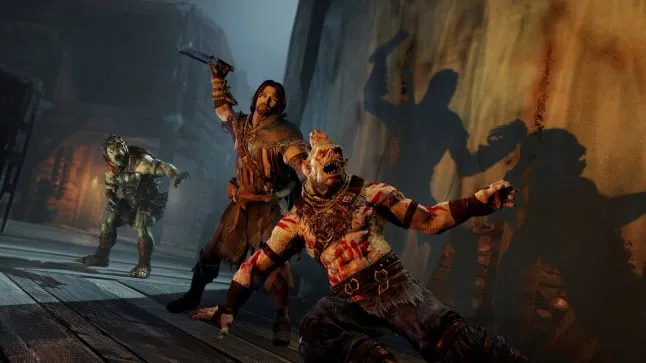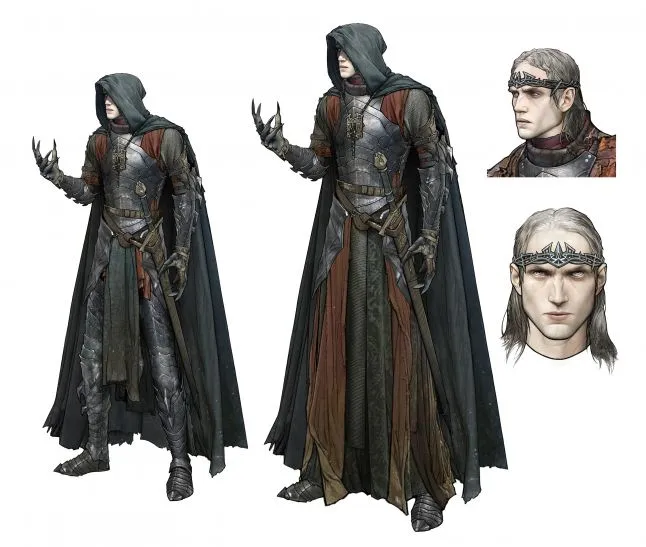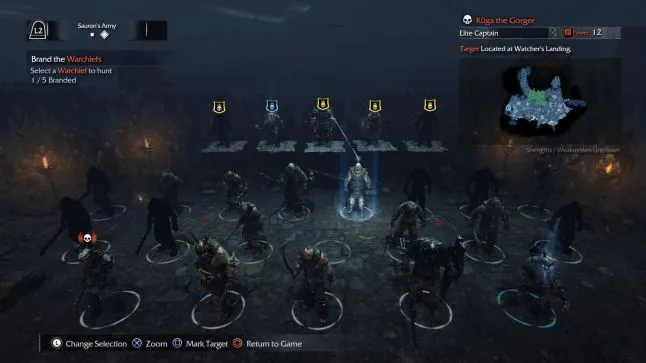Shadow of Mordor Fan Art League of Legends Logo
Michael de Plater is design director at WB Games studio Monolith Productions.
Middle-earth: Shadow of Mordor shipped worldwide get-go Sept. 30, 2014. Shadow of Mordor was an aggressive game around which we built our electric current team here at Monolith Productions, and it was the beginning time many of us had worked together.
For the majority of the team it was our commencement third person, open world action game not to mention our beginning "new gen" championship.
This combination of factors made it an enormously educational feel seeing how far we can improve. The post-obit list is a small sample of our experience gained over the last three years in development.
What went right
The benefit of hindsight and the fact that the end result turned out quite well makes some of these wins seem clearer and more obvious than they did at the time.
1. The Nemesis Organisation
There were two main goals which drove our focus on the Nemesis System. The first was a commitment to creating systems which empowered players to create and share their ain stories. The second was for united states to leverage the new generation hardware through our innovation.
Nosotros played to Monolith Productions' strengths every bit a squad and a studio in crafting innovative Artificial Intelligence, for case in F.East.A.R. With Shadow, we targeted our efforts on having the NPCs react and reply to the player, the surroundings and each other. Focusing on this from the outset informed many of the blueprint decisions up to and including our core innovation revolving effectually AI and NPC behavior.

Bringing this system to life was a result of very strong cantankerous-discipline collaboration. At that place was no role of the team not strongly involved in the Nemesis Organisation – writing and VO, AI, blitheness and facial animation, cameras, game design, UI and level design. With all the pieces in place, Grapheme Art did an astonishing job realizing our Uruks as a rich set of unique and hideous snowflakes.
Equally shortly as the game launched, we began to see players creating and sharing their own videos and stories of their experience of the Nemesis System and how much they loved to hate their enemies. Giving players the tools to create and share their personal stories is going to be a key pillar of all our work going forward.
2. Core Gameplay and Controls
We were adamant to introduce our systems and AI. It was critical that the cadre gameplay, the controls and the camera supported the players intention at all times. We aimed for controls to be immediately accessible, if not "choice upwards and play," given the depth of options for melee, stealth, ranged and movement gameplay.
Our goal was to match the "best in form" cadre gameplay quality of the genre nosotros were entering, which we clearly identified as the Arkham serial past Rocksteady. Arkham is also published by Warner Bros. Interactive Amusement and we wanted players to perceive that we were trying to emulate their arroyo to a licensed IP by focusing on quality, contained of the blockbuster movies which are coming out in parallel.
Having said that, it's 1 thing to aim to model your gainsay on Arkham and quite another thing to execute on that intention. The core component of the success was the close collaboration of Design and Blitheness besides as our in house MoCap facilities.That allowed us to take a continuous and fast iteration process on every move in the game.
Between the player animations and the diverseness of classes, abilities and moves in the Nemesis Organisation this was a hugely challenging task. What we learned was that seemingly lilliputian changes to animation or timing can have enormous implications on gameplay and rest.
3. Usability and QA
These are actually 2 separate topics, merely they have in common that they allowed u.s.a. to iterate more than speedily and close strongly.
Our Usability lab was not but continually bringing in playtests of all ability levels to play Shadow of Mordor, simply also continually benchmarking confronting contest so we had some context against which to clarify the incoming data. We held regular playtests among the squad, where everyone had the responsibility to play and give feedback.
This had multiple benefits. Near evidently it made everyone more than familiar with the game, and more committed to improving it. Secondly, past beingness obliged to provide feedback, it increased everyone'due south sense of ownership and fabricated people more comfortable with communicating tough or negative feedback across disciplines.
Additionally, we had very strong and experienced in-firm QA. This was the one cadre discipline on the squad that did have a wealth of third person action game experience. They besides provided the most conservative and realistic assessment of what it was going to take to go from Blastoff to Beta and from Beta to Concluding, which enabled us to hit our dates and transport on time.
4. Proprietary Tech
I mentioned at the start that this was our first third person, open world activeness game, however we had an enormous advantage in having our own engine and an extremely experienced engine and tools team.
Monolith Productions has historically created games beyond a very diverse range of genres, from FPS to MMO to Strategy and the power to adapt to the requirements of our design was a huge asset which made everything else, including the Nemesis System possible.

Some other big win for Shadow of Mordor was that the entire studio and squad were focused on a single game, where previously Monolith Productions had been developing multiple titles in parallel.
This singular focus allowed the engineering team to direct all of their efforts towards new platform adoption and optimizing both the runtime systems and the tools to the requirements of a single game.
Another big win was our robust build infrastructure, which allowed us to get vetted changes out to the team rapidly and always have a stable version of the game running to test and play. This was essential to our ability to rapidly iterate.
5. Publisher Support
Arkham had shown stakeholders that the correct way to approach a license was not to brand a "movie game." It is to brand the all-time game that you can, that plays to the strengths of games as a medium and respects i of the world'southward most prestigious IPs.
Within Warner Bros. Interactive Amusement and from our Licensors this was the mandate we were given, that is to focus on quality and innovation. So we were supported every pace of the fashion, for instance by having access to WETA Workshop in New Zealand, having a bang-up presence at E3 2014 and stiff marketing support at launch.
The level of communication and feedback from executives and partners was clear and well informed and we were able to remain aligned on our goals throughout the projection, including our approach to IP and our focus on the innovation of the Nemesis Arrangement.
What went incorrect
So that was the fun stuff, seen through the rosy glasses of hindsight… I think it's the "what went wrong" issues that actually constituted our almost pregnant learnings. "What went right" is usually more obvious and intuitive, even if it's very challenging in execution, "what went wrong" is a test of the teams' ability to adapt and overcome…
1. First Timers
This was our offset third person, open up globe action game and for many of us our first project as a team. This created many challenges and a lot of doubt, especially in combination with our focus on an innovation such every bit the Nemesis System.
We not only had to trust each other in terms of the procedure of creating the game, we too had no clear benchmarks or data to demonstrate that it would work even one time it was created. This insecurity nearly our core systems led us to direct a lot of endeavour to peripheral systems such equally side activities and even some epic features similar a climbable Keen Beast that later got cut.
Ultimately, as the Nemesis Arrangement started to prove itself through Usability, we became very focused on two things – our innovation and the core gameplay. Ane of the fundamental ways that we tried to stay on target was to "always be shipping" – that is to accept meaningful consumer facing demos or deliverables no more than than iii months apart. Sometimes demos, such as E3, can be treated as inconvenient distractions from the main production and schedule.

We treated them as our top priority as they helped us go alignment on the goals of the game, as well equally to define clear targets for final quality. Additionally, they helped us generate meaningful data and metrics on how long it took to produce content at a shippable level of quality. This in turn allowed u.s.a. to become progressively more than authentic in our scheduling.
2. Over Ambitious
During pre-production, nosotros didn't have good metrics on our product capacity. This led to the specification of the game existence over-ambitious, which as we started to get a clearer film of reality required united states to make some pretty big and painful cuts.
This created a double dip of pain; firstly there was the lost work on the features that were cut. Secondly nosotros created quite significant amounts of new work to replace the cutting features or content including some large wilderness areas and ballsy creatures such as the Cracking Animate being mentioned above.
Because even when a feature or quantity of content is cut something has to be redesigned and created to have its identify and often that work in its plough was greater than we had predictable.
3. Nemesis System Churn
The Nemesis System started with a fairly simple idea of personal villains, then during pre-product, it went through quite a bit of feature pitter-patter which fabricated information technology significantly more complex and took it further abroad from the core promise.
For case at one point nosotros had multiple Uruk Factions with dissever confined for Morale and Bailiwick, each Helm influenced these Bars and their state determined the behavior of the Orcs in gainsay equally well as emergent missions. At this point, their Hierarchy UI looked somewhat like a Christmas tree.
So as we play tested and refined the gameplay, we progressively returned to something closer to the original focus, but with some fundamental improvements based on the systems we had created under the hood. Having said that, some stiff features did come out of the exploration, in particular the Domination feature and the ability to create your own followers and direct control how the Uruks plow against each other.

This was an improvement and evolution over the original vision which was closer to Sam and Frodo'south feel in Cirith Ungol, where interrogation did non have any magical backdrop and you were turning your enemies against each other. The terminal game is closer to the idea of the power of the One Band where you are directly decision-making your Enemies.
4. Communicating our Innovation
Throughout evolution, we didn't practice a dandy job of communicating the hope of the Nemesis Organization, either internally or externally. This created an additional burden of caption each fourth dimension we demoed or pitched the game and fabricated the game feel more systemic and mechanical than we wanted.
Players and reviewers ultimately did a much meliorate job of expressing their ain user stories than we had, and this was the tipping indicate when people really "got it". This taught u.s. the power of giving players the tools to share their experiences and stories with each other and how meaningful those stories can be. This led us to prioritize the evolution of Photograph Mode feature that nosotros added later release in order to support thespian expression.
five. Condensing to One Squad
One of our major challenges during the course of development was that Monolith Productions condensed a couple of smaller game teams that were finishing products into a big, single team set-up.
This meant that new team members had to exist integrated together very apace, and new production processes had to exist re-organized for best efficiency and results. Some squad members besides had to adapt to working on a new genre.This had the potential to be extremely confusing and there were bumps forth the road as we worked toward those goals.
However, the central to united states of america all beingness in the same boat was that information technology forced us all to paddle in the same direction. Becoming a unmarried team studio delivered a level of focus which made the growing pains inherently lilliputian. Actually, we are possibly cheating a flake here by listing this point under "what went wrong," because perhaps more than than any other bespeak this single squad focus was key to our success.
Decision
The 3 years of the development of Shadow of Mordor were at various times stressful, educational and inspiring. We didn't just brand a game, nosotros also made a smashing squad. But in the end, our goal will exist to give players the tools to surprise us with their awesome stories.
Source: https://www.gamedeveloper.com/audio/postmortem-monolith-productions-i-middle-earth-shadow-of-mordor-i-
0 Response to "Shadow of Mordor Fan Art League of Legends Logo"
Post a Comment